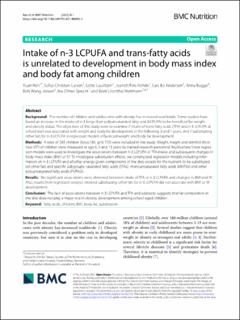| dc.contributor.author | Ren, Xuan | |
| dc.contributor.author | Larsen, Sofus Christian | |
| dc.contributor.author | Lauritzen, Lotte | |
| dc.contributor.author | Rohde, Jeanett Friis | |
| dc.contributor.author | Andersen, Lars Bo | |
| dc.contributor.author | Bugge, Anna | |
| dc.contributor.author | Jensen, Britt Wang | |
| dc.contributor.author | Specht, Ina Olmer | |
| dc.contributor.author | Heitmann, Berit Lilienthal | |
| dc.date.accessioned | 2022-02-14T11:23:12Z | |
| dc.date.available | 2022-02-14T11:23:12Z | |
| dc.date.created | 2022-01-26T08:57:35Z | |
| dc.date.issued | 2022 | |
| dc.identifier.citation | Ren, X., Larsen, S. C., Lauritzen, L., Rohde, J. F., Andersen, L. B., Bugge, A., . . . Heitmann, B. L. (2022). Intake of n-3 LCPUFA and trans-fatty acids is unrelated to development in body mass index and body fat among children. BMC Nutrition, 8:1. | en_US |
| dc.identifier.issn | 2055-0928 | |
| dc.identifier.uri | https://hdl.handle.net/11250/2978725 | |
| dc.description.abstract | Background
The number of children and adolescents with obesity has increased worldwide. Some studies have found an increase in the intake of n-3 long-chain polyunsaturated fatty acid (LCPUFA) to be beneficial for weight and obesity status. The objectives of this study were to examine if intake of trans-fatty acids (TFA) and n-3 LCPUFA at school start was associated with weight and body fat development in the following 3 and 7 years, and if substituting other fats for n-3 LCPUFA in regression models influenced weight and body fat development.
Methods
A total of 285 children (boys:130, girls:155) were included in this study. Weight, height and skinfold thickness (SF) of children were measured at age 6, 9 and 13 years by trained research personnel. Multivariate linear regression models were used to investigate the associations between n-3 LCPUFA or TFA intake and subsequent changes in body mass index (BMI) or SF. To investigate substitution effects, we constructed regression models including information on n-3 LCPUFA and all other energy given components of the diet, except for the nutrient to be substituted (all other fats and specific subgroups; saturated fatty acids (SFAs), monounsaturated fatty acids (MUFAs) and other polyunsaturated fatty acids (PUFAs)).
Results
No significant associations were observed between intake of TFA or n-3 LCPUFA and changes in BMI and SF. Also, results from regression analysis showed substituting other fats for n-3 LCPUFA did not associate with BMI or SF development.
Conclusion
The lack of associations between n-3 LCPUFA and TFA and adiposity suggests that fat composition in the diet does not play a major role in obesity development among school-aged children. | en_US |
| dc.language.iso | eng | en_US |
| dc.publisher | BMC | en_US |
| dc.rights | Navngivelse 4.0 Internasjonal | * |
| dc.rights.uri | http://creativecommons.org/licenses/by/4.0/deed.no | * |
| dc.title | Intake of n-3 LCPUFA and trans-fatty acids is unrelated to development in body mass index and body fat among children | en_US |
| dc.type | Peer reviewed | en_US |
| dc.type | Journal article | en_US |
| dc.description.version | publishedVersion | en_US |
| dc.rights.holder | © The Author(s) 2021. | en_US |
| dc.source.volume | 8 | en_US |
| dc.source.journal | BMC Nutrition | en_US |
| dc.identifier.doi | 10.1186/s40795-021-00493-5 | |
| dc.identifier.cristin | 1990059 | |
| dc.source.articlenumber | 1 | en_US |
| cristin.ispublished | true | |
| cristin.fulltext | original | |
| cristin.qualitycode | 1 | |

